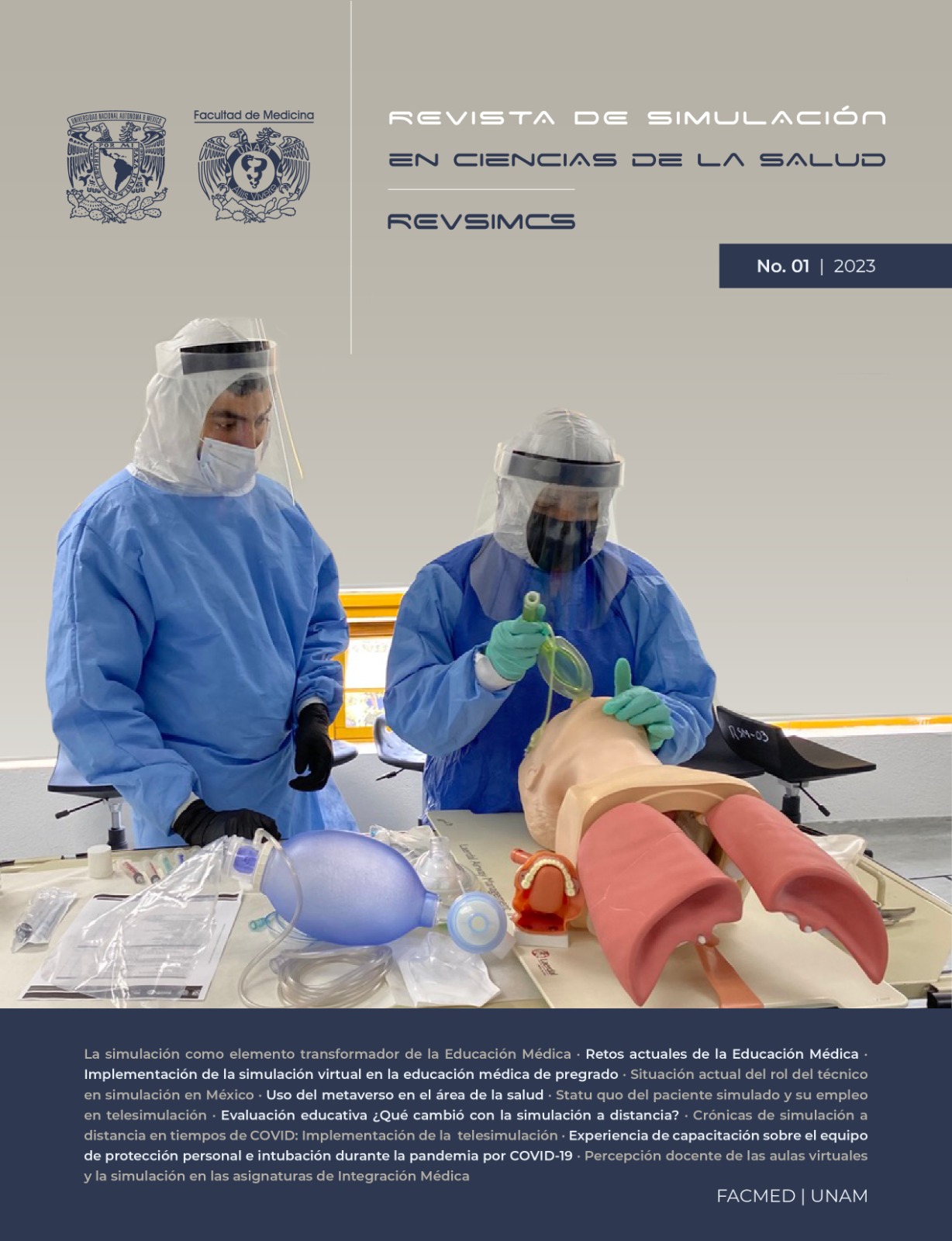Chronicles of remote simulation in times of COVID: Implementation of telesimulation
DOI:
https://doi.org/10.22201/fm.30617243e.2023.1.15Abstract
During the pandemic, simulation became a path of continuing the training of professionals through different modalities, despite social distancing measures. The Center for Teaching and Certification of Medical Skills (CECAM) of the School of Medicine implemented telesimulation in order to give continuity to the academic program of Basic Clinical Integration I and II. The objective is to describe the implementation of telesimulation in the CECAM with the Kern model because these
steps allow the design of scenarios in a structured way and oriented to the fulfillment of the study plan. Telesimulation is emerging as a strategy that allows students to continue training even in times of crisis.
References
Althoff, A. (2018). Examining faculty barriers with simulation and successful student learning outcomes. [Tesis doctoral, Northern Illinois University].ERIC. https://eric.ed.gov/?id=ED588561
Brett-Fleegler, M., Rudolph, J. (2012). Debriefing assessment for simulation in healthcare: development and psychometric properties. Simulation in healthcare : journal of the Society for Simulation in Healthcare, 7(5), 288–294. https://doi.org/10.1097/SIH.0b013e3182620228
Cheng, A., Kolbe, M., Grant, V., Eller, S. (2020). A practical guide to virtual debriefings: Communities of inquiry perspective. Advances in Simulation, 5(1), 18. https://doi.org/10.1186/s41077-020-00141-1
Facultad de Medicina. (2009). Plan de Estudios 2010 y Programas Académicos de la Licenciatura de Médico Cirujano. http://www.facmed.unam.mx/plan/PEFMUNAM.pdf
Facultad de Medicina. (2019). Plan 2010. Integración Clinico Básica II. http://dicim.facmed.unam.mx/wp-content/uploads/2019/11/Programa-Acade%C-C%81mico-ICB.II_.pdf
Facultad de Medicina. (2020). Plan 2010. Integración Clínico Básica I. http://www.facmed.unam.mx/fm/pa/2018/020306_ICBI.pdf
Gaba, D. M. (2004). The future vision of simulation in health care. Quality & safety in health care, 13(Suplemento 1), i2–i10. https://doi.org/10.1136/qhc.13.suppl_1.i2
García-Barbero, M. (2006). El valor educativo de la telemedicina. Educación Médica, 9(Suplemento 2), 38-43. http://scielo.isciii.es/scielo.php?script=sci_ar-ttext&pid=S1575-18132006000700008&lng=es&tln-g=es
Gutierrez-Barreto, S. E., Argueta-Muñoz, F. D., Ramirez-Arias, J. D. (2021). Implementation Barriers in Telesimulation as an Educational Strategy: An Interpretative Description. Cureus, 13(9).
Hayden, E. M., Khatri, A., Kelly, H. R., Yager, P. H., y Salazar, G. M. (2018). Mannequin-based Telesimulation: Increasing Access to Simulation-based Education. Academic emergency medicine : official journal of the Society for Academic Emergency Medicine, 25(2), 144–147. https://doi.org/10.1111/acem.13299
INACSL Standards Committee. (2016, December). INACSL standards of best practice: SimulationSM Simulation design. Clinical Simulation in Nursing, 12(S), S5-S12. http://dx.doi.org/10.1016/ j.ec-ns.2016.09.005
Leighton, K., Ravert, P., Mudra, V., y Macintosh, C. (2015). Update the Simulation Effectiveness Tool: Item modifications and reevaluation of psychometric. properties. Nursing Education Perspectives, 36(5), 317‐323. https://doi.org/10.5480/15‐1671.
Manrique-Gutiérrez G., Motte-García E., Naveja-Romero J. (2021). Cambios y estrategias de la educación médica en respuesta a la pandemia por COVID-19. Revista Investigación En Educación Médica, 10(38), 1-17. https://doi.org/10.22201/fm.20075057e.2021.39.21360
McCoy, C. E., Sayegh, J., Alrabah, R., y Yarris, L. M. (2017). Telesimulation: An Innovative Tool for Health Professions Education. AEM education and training, 1(2), 132-136. https://doi.org/10.1002/aet2.10015
Multak, N. (2018). Implementing Simulation in the Curriculum. En L. Wilson y R. A. Wittmann-Price (Eds.), Review Manual for the Certified Healthcare Simulation EducatorTM (CHSETM) Exam (Capítulo 15; 2da ed., pp. 197-208). Springer Publishing Company. https://doi.org/10.1891/9780826138897.0015
Nelsen, B. R., Chen, Y. K., Lasic, M., Bader, A. M., y Arriaga, A. F. (2020). Advances in anesthesia education: increasing access and collaboration in medical education, from E-learning to telesimulation. Current opinion in anaesthesiology, 33(6), 800-807.https://doi.org/10.1097
Patel, S. M., Miller, C. R., Schiavi, A., Toy, S., y Schwengel, D. A. (2020). The sim must go on: adapting resident education to the COVID-19 pandemic using telesimulation. Advances in simulation (London, England), 5, 26. https://doi.org/10.1186/s41077-020-00146-w
Sanko, J. S., Shekhter, I., Gattamorta, K. A., y Birnbach, D. J. (2016). Development and Psychometric Analysis of a Tool to Evaluate Confederates. Clinical Simulation in Nursing, 12(11), 475-481. https://doi.org/10.1016/j.ecns.2016.07.006
Vera, M., Kattan, E., Cerda, T., Niklitshek, J. (2021). Implementation of Distance-Based Simulation Training Programs for Healthcare Professionals: Breaking Barriers During COVID-19 Pandemic. Simulation in healthcare: Journal of the Society for Simulation in Healthcare, 10.1097/SIH.0000000000000550. Advance online publication. https://doi.org/10.1097/SIH.0000000000000550



